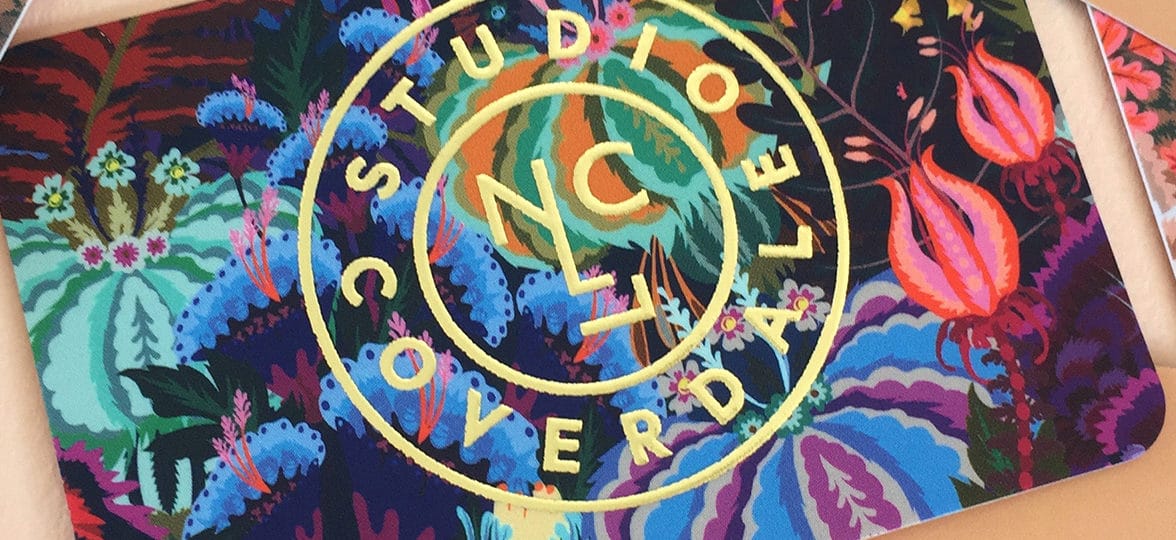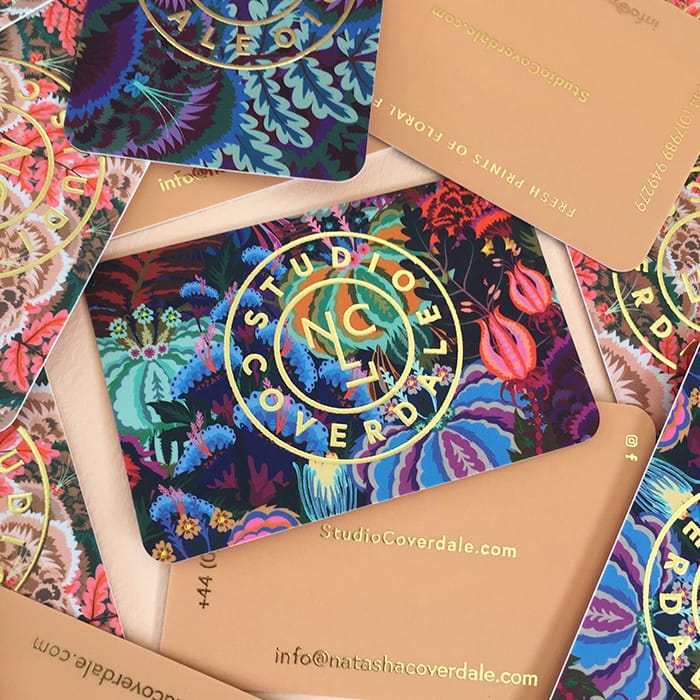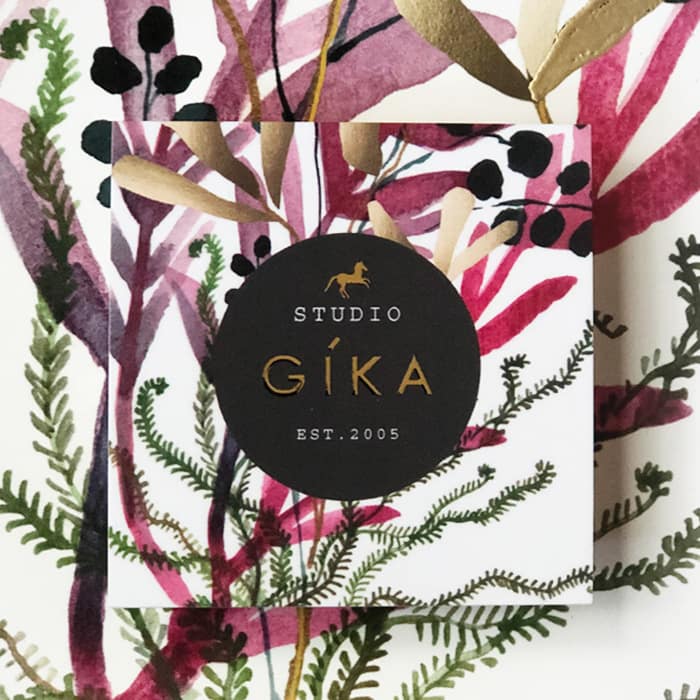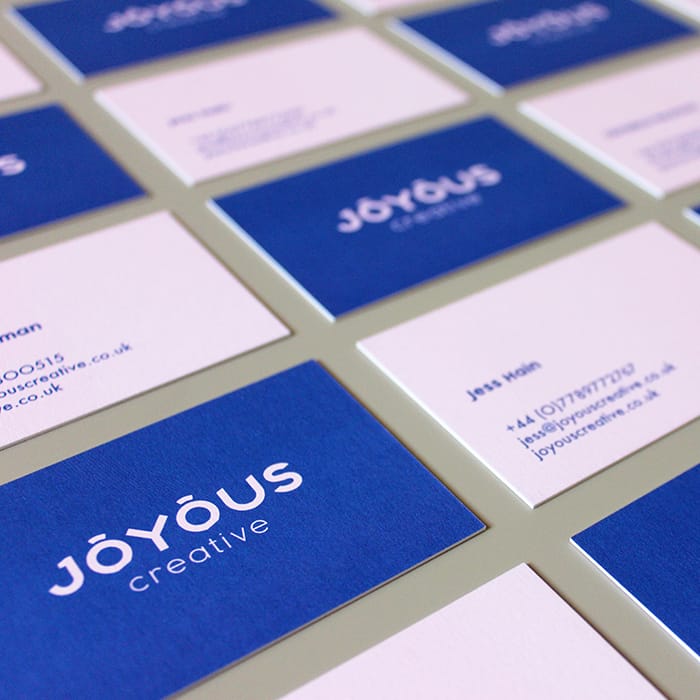13 designers on how they found their perfect font

Got a taste for type? Join the club. Finding the perfect font for your brand is tough – especially with so many swoon-worthy serifs to choose from. Check out our roundup of the typefaces our creative community are loving.
Studio Coverdale
Graphic designer Natasha Coverdale founded Studio Coverdale in May 2018, creating fantastical, floral, giclée art prints, posters and accessories that blend luxury with a pinch of playfulness. Her vibrant style is influenced by her time living in Hong Kong, Texas and Bangkok.

“For my business cards, I chose the Super Soft Touch paper with Gold Foil finish and Rounded Corners for a super opulent, luxurious feel. I wanted them to be desirable to represent my products, and be something people want to keep. I used a very simple sans serif typeface – Europa-Bold – it’s clean and timeless. The letter spacing and type design is simple enough to work well with my often maximalist designs, while being weighty enough to be stamped or foiled and still easy to read at a small scale.”
Studio Gika
After over a decade working as a graphic designer and illustrator, Aspa decided to shift her focus to visual art and painting. She now runs Studio Gika, where she showcases her nature-inspired art, and offers boutique design services.

“Since my paintings are mainly botanicals, I wanted to use a modern sans serif font with simplicity, so Acumin Pro wide was perfect for my branding—plus it looks great with the Courier Std font. With Printfinity, I can showcase multiple paintings, and because I use copper and gold accents in my work, the Gold Foil option was a great way to connect my cards to my branding. The overall effect is modern, yet elegant and luxurious.
Johanna Kanzler
After steadily building up her freelance projects, Germany-based graphic designer Joanna decided to spend time developing her own brand aesthetic. For her business cards, Joanna visualised the idea of functionality in graphic design, reducing the card’s content to minimalist typography, lines and tactile elements, but without a stiff and serious feeling.
“For my font, I chose Adrian Talbot’s Kamerik 205. I love the sense of structure it creates on the J and K of my initials. It has the perfect line weight to stand on Luxe uncoated paper, and still appears subtle, which I think suits my personality. To keep the design light and human, I introduced a bold red. As lines play a big role in my design elements, I matched this to the coloured seam that runs through the paper. This extra detail emphasises the printed lines, and makes the card feel more like an object as opposed to just a card.”
Next Creative Co.
With a passion for all things branding, Next Creative Co. help businesses communicate their authentic identity through branding, content, production and web development services. They’re inspired by the bold envelope-pushers who always look for the ‘what’s next?’ in the creative industry.
“We like to keep our brand bold and clean. So our cards only carry necessary information,” Digital Director, Rich Evenhouse, tells us. “We felt that anything more would just be clutter. We don’t like clutter. To create that ‘thud factor’, we chose Luxe paper. We wanted something that makes a statement, and between the weight of the card and the pop of colour in the middle, it does that for us. The font is modern and versatile, and we like to think we’re the same way. Like Montserrat, we can be bold and loud when we need to be, or subtle and refined when we don’t. Almost every time we hand our cards out, it stops people and often initiates conversation about our brand.”
Jae Dollason
Jae is an art director and graphic designer with a passion for design strategy. Her recent reinvention of her own personal brand was launched with the aim of showcasing her authentic creative identity to potential clients.
“I’ve always been aware that I’m obsessively more organised than the average creative. So, when it came to selecting typefaces, I wanted something that reflected my own personality. The Freight suite had everything I was looking for: versatility, professionalism, clarity, and balance. I chose to print on Luxe paper because of its tactility when you hold it – I want recipients to link that sense of wonder and depth to my own brand identity. The reaction has been great! Lots of ‘oohs’ and ‘aahs’, which is amazing. We’re most critical of ourselves, so when you’ve worked really hard to design something you absolutely love, you know you’ve done a good job.”
Jhonny T
Jhonny T is an independent creative, working towards his dream of becoming a clothing designer. With the ethos of less corporate more independent, Jhonny wants his label to blend “sporty chic” with timeless design to create ready to wear garments for men and women.
“I needed my cards to be a direct representation of me as a designer – I’m simple yet bold, and I tell stories. When it comes to typefaces, I always work to find the perfect marriage between contracting weights and cases of fonts. My style is versatile, and the consideration of the type on my design really gets that across. Sustainability is really important to me, so when I saw the eco-conscious choice of using Cotton stock, there was no question I’d go for it.”
Monique Renée
When she’s not developing graphic design courses for college students, Monique is running her own graphic design studio, specialising in editorial design and typesetting for everything from print through to digital media. Her passion for lifestyle and fashion and the 2019 Pantone Colour of the year inspired the design for her bold thank you cards.
“I love luxury fashion magazines and display fonts, so didones have always drawn me to their beauty. Salome (atipo foundry) is a fat didone, and lets me communicate that my brand is sophisticated and professional, without coming across as too lavish. I incorporated ellipsis marks in the Postcard design, because I always have so much more I want to say. I’m ‘old school’ when it comes to sending handwritten, heartfelt messages – it can change a person’s day when they open the mailbox. I want to show that I put care into every detail, and take time to ensure what I do makes someone feel good. By having strong, beautiful, feel-good cards, I accomplish this with every note.”
Little Life Studio
With a background in photography and media production, graphic design student Beth Nash has launched her own freelance career, producing alternative movie posters, illustrations and designs.
“I wanted to keep it simple and let my branding speak for itself. I went for Square Business Cards with a touch of Gold Foil to showcase my strong style and help me stand out to potential clients and agencies, plus I thought it would work well with my colour palette. I’m glad I treated myself to foil – I love the cards and they’ve gone down a treat! I’ve recently had some industry interviews and they’ve been a great talking point. Everyone’s wanted to keep one (or two).”
Joyous Creative
Creative duo Jess Hain and Christina Newman founded their multidisciplinary design business in 2018 after deciding to join their creative skills and graphic design experience. Their Joyous Creative brand is all about playfulness and freedom to create. So when it came to creating a visual identity, they went for a fresh and bright look to communicate their ethos of originality and fun.
“Have you ever seen a logo with eyebrows? Now you have! We created a custom font design for our logo, featuring cutouts at the base of the ‘O’s to create ‘eyebrows’ that sit above the text. The fun and curiosity of the font coupled with a simple, Grotesk typeface below really captures our studio vibe. As a design agency, it’s important our business cards reflected the quality of work we produce, and these feel really special and solid. It’s quite hard to stand out in a sea of cards, but the Luxe finish definitely catches your eye.”
Thick and Thin Films
Wedding videography company, Thick and Thin Films add a personal touch for their clients by sending a small thank-you gift with every booking. “Nothing beats a handwritten card,” says co-owner Mary Betsy. “We mail another one when we deliver a couple’s video along with a small business card, printed with a request to leave a review.”
“For our Business Cards and Postcards, we used Minion Standard Black because we wanted a serif font to honour the tradition and elegance of weddings, then paired that with a lightweight monospace sans serif font – Letter Gothic Standard – to add a modern touch. We love how our cards make clients feel about our brand: consistent, thoughtful, and a little funky.”
Ben Kinde
Working as a graphic and web designer in Portland, Oregon, Ben Kinde works with an architectural aesthetic across elements of typography, colour and space. His business cards were created to communicate authenticity and simplicity.
“For my typeface, I used Messina Serif in regular and italic. I love serif fonts for their human characteristics – their flare and imperfection. This felt like the right choice because it creates structural, geometric stability, while retaining its humanity. I went for the Cotton paper stock because it’s recycled, it’s soft and it ages beautifully. Over time, the identity of the product transforms for the user, and I think that’s pretty truthful of human experience.”
Megan Posas
Megan is a contemporary visual and performing artist, inspired by the architecture, people and natural beauty of her home in San Francisco. To house her ever-expanding portfolio, her business cards are printed with a selection of her latest paintings and old favorites.
“I love that with Printfinity, I can include so many different examples of my work – sometimes people want my card just so they can have a ‘mini-painting!’ For my information, I used elegant fonts – Sackers Gothic, Neue Haas Light, and Helvetica Neue LT Pro Light. They each have a delicate, round finish to them, which I think looks beautifully clean, high end, and contemporary. I want my artwork to be presented in an elevated way, and for that to be reflected in all of my branding.”
Winter Studios
Winter Studios is a husband and wife wedding videography team, with a passion for creating keepsakes that couples can enjoy for a lifetime. Before launching their own business, Nathan had previously been working as a graphic designer and videographer for a non-profit business.
“We had just renamed our business after our daughter, and needed a new logo. For the logo, I created a subtle ‘W’ shape with the trees, and matched it to the black seam of our Luxe cards. We used two contrasting but complementary typefaces, Archer and Gotham, to create a clean simple style. I think the modern fonts show people that our brand is contemporary and stylish, and our cards shout professionalism.”
Print your typographic creations to life with our range of premium print products.
The world of work is always evolving. As a startup founder, it’s important to keep up with the business trends around the world—and in your city—to build a memorable brand that attracts the brightest talent.
Startup Guide is a creative content company with a mission: to guide, empower and inspire people to start their own business anywhere. The company makes startup guidebooks to help aspiring entrepreneurs get the most out of their surroundings. With 17 different city guides made and a growing team of passionate employees, the company is showing no signs of stopping soon. MOO spoke with founder Sissel Hansen and COO João Mira about the origins of this unique startup.
Tell us about Startup Guide. How did you come up with this unique idea?
SH: Startup Guide is a creative content and publishing company that produces guidebooks and tools to help entrepreneurs navigate and connect with different startup scenes around the world. I founded the company in 2014, after moving from Copenhagen to Berlin to start a business and realized how difficult it was to find resources, practical information and people to talk to about this process. Soon enough, I noticed a lot of people were in the same boat and while gathering research on this, I thought, ‘Why not make this information accessible to others to help them navigate the startup scene in Berlin?’ That year, Startup Guide Berlin came out—and it sold out in 48 hours.
Now, we have books in 17 cities across Europe and the Middle East and have opened two physical stores in Berlin and Lisbon, which also serve as our offices, to promote and sell products by startups. We’ve grown to a 20-person team based in both cities. Recently, we also launched a platform that complements our books and aims to streamline the process of setting up a business in each city by simplifying administrative tasks such as registering for a bank account, sifting through legal requirements or getting a VAT number among other things.
What exactly do you cover in each edition of the Startup Guide?
JM: The Startup Guide books are based on traditional guidebooks that can be carried around everywhere and each edition is packed with facts and figures about the city, practical information, inspiring entrepreneur stories, coworking spaces to work at and insightful interviews with local experts.
What are the common threads between each of these cities and their cultures?
SH: All startup ecosystems consist of more or less the same elements: talent, funding, universities, corporations, investors, a good infrastructure – meaning a society that fosters and allows innovation. In terms of culture, we’re seeing that cultures where more people are willing to take risks have a tendency to generate more startups.
JM: Another common thread between the cities we’ve covered is the nature of the startup cultures. They all seemed to be influenced by the same well-known entrepreneurs, companies and startup stories. And this is undoubtedly because of the internet.
What do modern startups need from their cities in order to thrive as a business?
SH: Every startup can tap into the network of their own city to grow. Whether it’s a lawyer or an accountant, it’s so important for a startup to leverage the contacts in their local network because the closer you are with these people, the more likely you’ll receive the help you need. Instead of looking beyond their home city right off the bat, there’s so much value in looking within your city for info, a network and advice first. That was one of the main driving ideas behind Startup Guide—to help entrepreneurs make the best out of their local resources, programs, experts and network.
JM: More and more, startups are also needing their cities to modernize administrative services and tasks so things can happen more effectively and efficiently. Businesses are very different than they were a decade ago and I think everything from tax regulation and bureaucratic processes need to be updated in order for “modern startups” to thrive.
Do you have any tips to share with aspiring business owners on what to look out for when starting a business?
SH: For me, the “learning by doing” approach has been invaluable and I think it’s especially important when someone is just starting out in entrepreneurship. Of course, it’s important to educate yourself through reading, learning new things and talking to people, but you can’t only just sit and read and think to build a business. You have to actually do things and test them – and maybe fail – in order to learn, and then go from there.
As for the most overlooked aspect of starting a business, I definitely think it’s the processes and tasks needed to set up a company in the very beginning. I completely agree with João that these kind of admin tasks need to be modernized. In business school, we might be taught about how to target certain users or develop business models, but we never learn about the paperwork behind setting up a company, how to set up payroll or what a standard freelance contract might look like. People tend to underestimate these tasks at the very start, but they often end up being very time-consuming and complex. These are the kinds of things we want to help make simpler with our new platform.
What print products are most important to have when starting up a business?
JM: For us, it’s definitely been Business Cards. Even in 2018, everyone expects you to have a business card. Since we have two physical stores, people often come by and ask for our contact details because they have a product they want in the store or need our help with something. That’s when our Business Cards come in handy.
What’s featured on your MOO Business Cards and what did you hope to convey about the Startup Guide brand?
JM: Most of us use the Cotton Business Cards, which our Head of Design Joana Carvalho designed to convey key information about the company and what we do in a straightforward manner while still revealing a bit about our culture and team. We chose the MiniCards for our store managers. For those, Joana put the contact information for our stores in Berlin and Lisbon and intentionally left some blank space in the design to write down additional messages, if needed.
SH: For my cards, Joana chose to have three backside image options: a photo of the team, a picture of our main product – our books – and our logo. The idea is that I can pick one of three options to give out, depending on the conversation I’m in. For example, the team picture looks like one of the photos one might have of their loved ones in their wallet and could be a good ice breaker and at the same time it reflects the company spirit. It was great that MOO allowed us to make one order where there was more than one image on the backside of the cards.
Tell your brand story with MOO Business Services
At MOO, we’ve been helping people make their mark in the world with amazing quality print products for over a decade. And as our customers have grown, so has our service offering. That’s why for bigger businesses—with 10+ employees—we now offer MOO Business Services. It’s MOO + benefits. MOO Business Services combines dedicated account management with an easy online ordering platform and expert design services. It’s a complete package for businesses to give you more brand control and consistency—while saving you time, stress, and money in the process. Fill out the form here and a friendly Account Manager will reach out to you.
You don’t need to be a mega-corp to have mega business skills. Take a cheeky bite out of a big company’s years of experience with these lessons from the blue-chips.
1. It’s all about the relationships
Even in a world of automation and digital business, there’s one essential ingredient that only human beings can provide: trust. Without it, deals aren’t made, sales aren’t placed and things simply can’t happen.
One trust-fuelled success story is Airbnb, one of the big kahunas of the sharing economy. With a business model built around customers opening their homes with strangers, the trust factor is make or break. Airbnb has made it work using a strong brand built on ideas of connection, friendship and hospitality, backed up with a big investment in customer service to iron out any problems early in the process.
You can build trust in your business by keeping person-to-person connections solid with both staff and customers, being ready to talk face to face, and always following up on what you’ve said you will do. Conveying personal warmth in your branding, communications and deliveries helps too.
2. Be ready to fail to succeed
When you get things wrong, you learn stuff. The philosophy of being open to failure (or even ‘celebrating failure’) has a big following in the tech world, and it’s a habit well worth borrowing.
Apple is a great example of failing to succeed. Although it leads the list of today’s smartphone and computer must-have items, its journey to the top has been full of expensive and embarrassing mistakes – such as the PDA device that was ridiculed on The Simpsons, or the online ‘eWorld’ community that folded after two years in the 90s.
Failing well is all about asking what went wrong, why it happened and how to make things better in future. It works well on any scale, and it’s definitely better than ignoring or minimising negative outcomes, tempting though those approaches might be – just ask Steve Jobs.
3. Keep moving forward
What do you do when you’ve got a successful company that’s re-defining an entire industry? If you’re Elon Musk of Tesla, you open two more companies and keep all of them running at the same time. Musk added SpaceX (space travel) and Neuralink (brain-computer interfaces) to his to-do list alongside his senior role at the electric luxury car enterprise, and has investments and holdings in many more places.
Not that we’re saying you need to be a serial investor with multiple sci-fi-style projects on the go, but Musk is a great example of thinking big and refusing to rest on your laurels. If you’ve got the energy and ideas – use them. If today’s going great, what’s next? Can you make tomorrow even better?
4. Balance work and life
Google’s employees enjoy legendary benefits and perks, including free on-site gyms, education and learning benefits, time to pursue passion projects and amazing healthcare coverage. One of their most complimented strengths on employer review site Glassdoor is work-life balance.
Whether you’re a small start-up, a growing organization or a one-person business, the lesson is the same – people matter, and to get the best out of someone’s professional abilities, you need to treat the whole person with care and respect, including the times they’re not actively producing results for the business. This can be especially tough to do when you’re working for yourself, so make sure you prioritize self-care.































